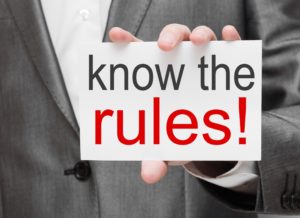Court of Appeals for the Federal Circuit Bid Protest Appeal – Patent Ambiguity-what-does-ambiguity-mean
What Does Ambiguity Mean?
 Many government contract bidders find the rules of patent ambiguity in solicitations to be very confusing. In many cases, they see the problem when filing a post-award bid protest. The recent decision at the US Court of Appeals for the Federal Circuit illustrates how important it is to protect your rights about the solicitation’s ambiguity early in the procurement process.
Many government contract bidders find the rules of patent ambiguity in solicitations to be very confusing. In many cases, they see the problem when filing a post-award bid protest. The recent decision at the US Court of Appeals for the Federal Circuit illustrates how important it is to protect your rights about the solicitation’s ambiguity early in the procurement process.
In the Court of Federal Claims bid protest appeal, three unsuccessful bidders challenged the decision of the United States Air Force’s award to Exelis Services A/S (“Exelis”).
The United States Court of Federal Claims ruled for the protestor’s motions for judgment on the administrative record and issued a TRO enjoining the government from moving forward with the contract in Greenland.
Latent and Patent Ambiguity Meaning? Latent Ambiguity vs Patent Ambiguity
In this case, the issue was whether the ambiguity was patent or not. Did the appellant meet the legal definition of patent? The Court of Appeals for the Federal Circuit stated that a patent ambiguity is present when the solicitation or government contract contains facially inconsistent provisions that would put a reasonable contractor on notice and prompt the contractor to resolve the inconsistency by inquiring of the appropriate parties. A defect is also deemed to be patent if it is “an obvious omission, inconsistency or discrepancy of significance.” E.L. Hamm & Assocs., Inc. v. England, 379 F.3d 1334, 1339 (Fed. Cir. 2004). There is somewhat if a striking difference in the latent and patent ambiguity meaning. See Special Rules When Appealing SBA COC & Small Business Certificate of Competency Decisions.
In contrast, the court also stated that a “[a] latent ambiguity is a hidden or concealed defect which is not apparent on the face of the document. It could not be discovered by reasonable and customary care. It also is not so patent and glaring as to impose an affirmative duty on the plaintiff to seek clarification.” Citing Analytical & Research Tech., Inc. v. United States, 39 Fed. Cl. 34, 46 (1997. Read about Are You a Bid Protest Intervenor? How to Intervene or Defend in A Bid Protest?
In the bid protest appeal to the federal circuit court, solicitation contacting a patent ambiguity. But the Air Force resolved the issue during its questions and answer period. As a result, the court ruled that the questions and answers from the government clarified the issue. The awardee, therefore, met the requirements of the solicitation.
Latent and Patent – Duty to Seek Clarification at the Bidding Stage
The Federal Circuit Court reminded contractors that when the Request for Proposal/solicitation contains a patent ambiguity, the contractor has a legal duty to seek clarification from the government. Failure to meet this requirement at the agency level constitutes a waiver from introducing the issue for the first time on appeal or even when filing a new protest at the Court of Federal Claims. The Circuit Court Cited Blue & Gold Fleet, L.P. v. United States, 492 F.3d 1308, 1313 (Fed. Cir. 2007).
The appeals court emphasized that questions and answers play a significant role in the bidding process. In this case, the issue was whether the awardee met the requirements of showing that it was a subsidiary of a foreign company.
What Happens When You Wait Too Late?
Understanding what ambiguity means in government contracting also means knowing when to act. Sometimes, the solicitation will provide you with the opportunity to ask questions. If not, you might want to consider filing a bid protest before the close of the bidding period. See Bannum, Inc. v. United States, 779 F.3d 1376, 1380 (Fed. Cir. 2015). See Contract Disputes Act COFC & Boards Appellate Jurisdiction.
Contractors must read the solicitation early and note the opportunity to clarify what could be either a patent ambiguity or latent ambiguity. Incorrectly labeling the type of uncertainty can also have the same disastrous effect if you wait too late to file a bid protest.
Again, this case shows that the appeal process to the Court of Appeals for the Federal Circuit serves an important purpose. It also shows the impact of the questions and answers in federal solicitations.
For help with filing an appeal from the Court of Federal Claims to the US Court of Appeals for the Federal Circuit, call our federal government contract attorneys at 1-866-601-5518. FREE INITIAL CONSULTATION.

One comment on “Court of Appeals for the Federal Circuit Bid Protest Appeal – Patent Ambiguity-what-does-ambiguity-mean”
Comments are closed.